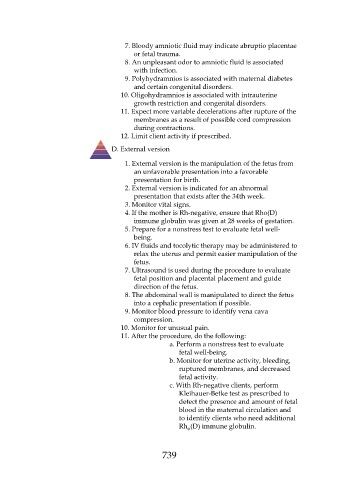Page 739 - Saunders Comprehensive Review For NCLEX-RN
P. 739
7. Bloody amniotic fluid may indicate abruptio placentae
or fetal trauma.
8. An unpleasant odor to amniotic fluid is associated
with infection.
9. Polyhydramnios is associated with maternal diabetes
and certain congenital disorders.
10. Oligohydramnios is associated with intrauterine
growth restriction and congenital disorders.
11. Expect more variable decelerations after rupture of the
membranes as a result of possible cord compression
during contractions.
12. Limit client activity if prescribed.
D. External version
1. External version is the manipulation of the fetus from
an unfavorable presentation into a favorable
presentation for birth.
2. External version is indicated for an abnormal
presentation that exists after the 34th week.
3. Monitor vital signs.
4. If the mother is Rh-negative, ensure that Rho(D)
immune globulin was given at 28 weeks of gestation.
5. Prepare for a nonstress test to evaluate fetal well-
being.
6. IV fluids and tocolytic therapy may be administered to
relax the uterus and permit easier manipulation of the
fetus.
7. Ultrasound is used during the procedure to evaluate
fetal position and placental placement and guide
direction of the fetus.
8. The abdominal wall is manipulated to direct the fetus
into a cephalic presentation if possible.
9. Monitor blood pressure to identify vena cava
compression.
10. Monitor for unusual pain.
11. After the procedure, do the following:
a. Perform a nonstress test to evaluate
fetal well-being.
b. Monitor for uterine activity, bleeding,
ruptured membranes, and decreased
fetal activity.
c. With Rh-negative clients, perform
Kleihauer-Betke test as prescribed to
detect the presence and amount of fetal
blood in the maternal circulation and
to identify clients who need additional
Rh (D) immune globulin.
o
739

